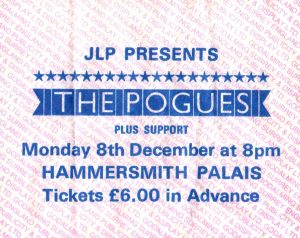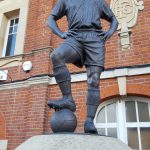Fulham 2 Everton 0
Premier League
Saturday 13 April 2019

Cottage industry
The context
A new ground for John, a well-loved one for me. I’m something of an Everton afficionado and I’d only missed 4 games at Goodison all season, so this had the added attraction of pitting the improving Blues against an already-relegated Fulham side that hadn’t won a point since before Christmas.
Craven Cottage is a famously charming location, tucked away next to the Thames in a leafy part of SW6. Fulham fans, meanwhile, have the reputation of being a self-effacing bunch, placid unless provoked and with more than a hint of quirkiness about them (for many years a wall on Stevenage Road sported the quintessentially Fulham-esque graffiti “Jimmy Hill is Satan’s friend”.) It was therefore a nice ironic touch when comedy writer John Sullivan made Fulham the favourite team of Wolfie Smith, Tooting’s self-styled urban guerilla.
The history
First things first. The famous house in one corner of the ground is not Craven Cottage, although people sometimes call it that. It’s actually a pavilion built at the same time as the Stevenage Road stand, and like it a Grade 2 Listed building. This listing ensures that at least one Leitch stand will survive in England, and this is a fine example – of similar scale and design to those at Selhurst Park and Dundee’s Dens Park, but with a level of detailing far superior to either and (in its own way) rivalling Leitch’s far grander handiwork at Ibrox.
Until this stand was built in 1905, the only seats at Craven Cottage were in a structure fondly known as the Rabbit Hutch. The Rabbit Hutch was actually four, er, hutches, each with its own pointed roof. It dated from around the time of the ground’s opening in 1896. Leitch’s employment (for a fairly lavish fee by the standards of the day) followed a dispute with London County Council in 1904, over what they saw as the inherently unsafe nature of this and the ground’s other buildings.
Redevelopment complete, Fulham’s home remained virtually unchanged until the Sixties – the familiar stand and three terraces model, with the “long” terrace in this case backing onto the Thames and much in demand during the annual Oxford-Cambridge boat race. In its later days this terrace boasted an electronic scoreboard and flagpoles with flags from all the other First Division clubs. The Hammersmith End terrace was roofed in 1964, using money from the sale of Alan Mullery to Tottenham. And then, in 1972, a new riverside stand went up – commissioned, and named for, the then chairman, Eric Miller.
- 1960s
- 1970s
And oh yes, Craven Cottage. The original Cottage was built in 1780 by William, Baron Craven, on the site of a Royal hunting lodge at the edge of what was then a densely wooded area within Ann Boleyn’s one-time hunting grounds. Situated near the present centre circle and with the Palace of the Bishop of London a short way to the south, it was home at various times to Edward Bulwer-Lytton and Sir Arthur Conan-Doyle. When the house burned down in 1888, the site was taken over by Fulham and became their 9th ground in as many years.
- old cottage
- new cottage
The journey
We parked at West Ruislip, caught the tube to Notting Hill Gate and changed for Putney Bridge. On its gentle southern meander through West London’s choicer suburbs, the District Line was a sunny ride hardly underground at all. But for fans of a certain age this still feels like bandit country. Parsons Green had its moments back in the day, but say “High Street Ken” to an old-school Evertonian and they will wince. This was the scene, in 1978, of a gruesome, bloody Chelsea ambush that created bad feeling for years and led to the sprayed message, only recently removed from the outside of Lime Street station, exhorting those keen for revenge to take the “Ordinary to Chelsea” for Liverpool’s visit a few weeks later.
From Fulham Broadway tube it’s a stroll in the park to find the ground – literally, as the walk along the riverbank passes though Bishop’s Park, the historic gardens of the Bishop of London. This park holds a nice memorial to the International Brigade. It was also used as a filming location for The Omen, in which Gregory Peck and the priest played by Patrick Troughton meet on the Thames Path – a memorable scene during which Troughton is pursued by a demonic wind to All Saints Church, and ends up skewered by a falling lightning conductor.
The ground
By the mid-1990s, after a decline into the lower leagues, Craven Cottage was in a sorry state. Yet following an injection of cash by Mohamed Al-Fayed the club climbed to the top flight, with its all-seater and other requirements. To add to the conundrum, redevelopment or relocation proved hard to achieve in an up-market neighbourhood at once protective of property prices and lacking in open space. In this unpromising climate, Fulham decamped to groundshare with QPR for a few years and considered their next move. And as a result the old place is nowadays much changed – but at the same time, not much changed at all.
The answer, quite simply, was prefabrication. New cladding for the old stands, new lightweight roofs for the two ends, new metal seated steps covering the old concrete ones, new metal floodlight poles. Visiting now, and with the obvious exception of the Stevenage Road (now Johnny Haynes) Stand, its hard to know what’s permanent and what isn’t. The girders supporting the Hammersmith End seating tier, for example, look original: I was sure I could see the old terraces underneath in one or two places. But in many ways this now feels like one of those festival stadia that are knocked up quickly and can be taken down again just as fast.
For all that, Leitch’s classical frontage remains a thing of beauty. It seems to have been sandblasted since my last visit, and has also gained a fine statue of Haynes, Fulham’s doyen of the 1950s and 1960s. And there is still an area, at the side of the Hammersmith, where you can pause and watch the river go by. It was a bit more crowded than I remembered, but I suppose that’s progress.
Flesh and wine
Part of me wanted to follow in the footsteps of the Pogues and “Drink with my friends/In the Hammersmith Broadway/Dear dirty delightful old drunken old days.” But I’d made a loose arrangement (too loose, as it turned out) to catch up with Cassie from Conifa/Women In Football at the Spotted Horse on Putney High Street, so instead we jumped forward a couple of albums and walked down by the riverside.
Putney is, to put it bluntly, posh. That created an interesting matchday juxtaposition of wealthy people out and about on their normal business, the broad spectrum that is Fulham’s fanbase and a few thousand visiting fans in varying shades of scally-ness. It also meant a lack of takeaways, other than those clearly striving for the hipster market and therefore disqualified on grounds of pretension and cost. And it meant pubs either wouldn’t let us in (the King’s Arms) or didn’t serve proper beer (the unexpectedly vast, dingy and raucous Temperance).
The Spotted Horse is actually Ye Olde Spotted Horse, an Edwardian remodelling of a 17th centrury boozer. It was uncrowded and amicable, and down to earth without being “artisan”, but unfortunately – in a reprise of the Black Bull/Black Horse misunderstanding in Inbetweeners – Cassie was in a different pub entirely. However we later bumped into one another by accident after the match, so that just goes to show how unnecessary planning is.
I’d heard good things about the pies at Craven Cottage, a rumour that proved well-founded (although it was a pasty in the end). John, meanwhile, played Russian roulette with a succession of burger stalls in the park, couldn’t make up his mind, decided to eat inside the ground, failed to find anything he fancied and as a consequence went hungry.
The game
As ever we hadn’t been particularly quick or organised when buying tickets, so our seats – in the Hammersmith End/Riverside corner – were a bit subterranean. But luckily the many beefy stewards in the vicinity (including the frankly scary Pitch Runner) kept out of the way by sitting in a sort of trench, so our views of Aleksandar Mitrovic’s chunky thighs and the Swan Vesta-like Ryan Babel were unimpeded.
Ex-Liverpool enigma Babel was the star of a solid home performance, although in truth a pedestrian Everton defence did little to stop him playing. After a first half in which both he and Mitrovic caused trouble for Jagielka and Zouma, it took the scarlet-headed one fewer than 30 seconds after the restart to cut the ball back for Cairney to place his shot beyond Pickford. This woke Everton up a little, and Calvert-Lewin hit the post before Babel made sure of the points with a tidy finish after a charging run down the centre of the dozy Everton rearguard.
Fulham were worthy winners and it was hard to begrudge their clacker-waving crowd the chance to celebrate for a change. An equal sharing of miseries, as Citizen Smith might have said.
- dirty old river
- homage to Catalonia
- bulldog breed
- cottage sky
- premier attraction
- making an entrance
- clean sweep
- hose with attitude
- prefab clout
- Miller’s tale
- subterranean
- hot Digne-ity dog
- gentleman George
- Haynes manual
- journey’s end
Teams and goals
Fulham: Rico, Fosu-Mensah (Christie 66), Le Marchand, Ream, Bryan, Chambers, Zambo Anguissa (Odoi 89), R Sessegnon, Cairney, Babel (Seri 83), Mitrovic. Unused subs: Kebano, Schurrle, Fabri, Elliott.
Everton: Pickford, Coleman, Jagielka, Zouma, Digne, Andre Gomes, Gueye, Richarlison (Tosun 84), Sigurdsson (Lookman 74), Bernard (Walcott 84), Calvert-Lewin. Unused subs: Baines, Keane, Stekelenburg, Davies.
Goals: Cairney 46, Babel 69
Attendance: 24,971.































